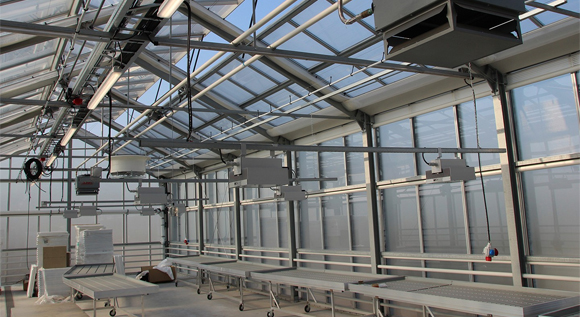How glass foil roofs save resources
The „Light Light Roof” research project is creating a novel lightweighting system for roofs which combines a glass-foil module with an inside roof made of a light-permeable fabric that reflects infrared radiation. It thus combines CO2 reduction, lightweighting and resource efficiency.
 © Fraunhofer UMSICHT
© Fraunhofer UMSICHT
Glass roofs cover railway stations, swimming pools and malls. Manufacturing what tend to be heavy panes of glass consumes a lot of resources. The Fraunhofer Institute for Environmental, Safety and Energy Technology (UMSICHT) is therefore researching foil-based materials for roofs that let light through. In the „Light Light Roof” project, the researchers are developing an innovative, light and modular lightweight construction system: a combination of a glass-foil modular system and an inside roof of mobile, light-permeable and IR-reflecting fabric.
Lightweighting is regarded as a key element of the energy transition
Heavy glass roofs have a detrimental impact on the overall building design, the transport of materials, and the construction work. „The design and the materials enable the combination of foil and glass to attain weight savings of up to 75% compared with conventional multi-pane glass systems whilst improving functionality”, explains Dr Holger Wack, Deputy Head of Product Development. Lightweighting is regarded as a key element of the energy transition. This is because the cross-cutting technology combines great economic potential with savings in resources and carbon emissions.
The researchers are using the „Altmarktgarten Oberhausen” rooftop greenhouse to test the glass-foil roof over up to 160 square metres in year-round operation. Air from the building can be circulated in the space between the glass pane and the foil. This makes it possible to melt layers of snow or ice in the winter, and provides some thermal insulation. Depending on the level of solar radiation, the temperature and the amount of light, the researchers can set the interior roof as required by means of specially developed integrated measurement and control technology. Going forward, it will be possible to control it online via a Cloud.
Foil-based materials for a variety of applications
Architects will be able to use the foil-based materials to design leaner and lighter buildings since the structure has to bear less of a load and cope with less snow. This makes the stable lightweight roofs interesting not only for horticulture and plant traders, but also for example for the planning and building of façades.
The research project runs until the end of 2023, and is receiving funding from the Lightweighting Technology Transfer Programme (TTP LB), which provides €73 million each year to support the transition to a climate-neutral and competitive industrial sector.

